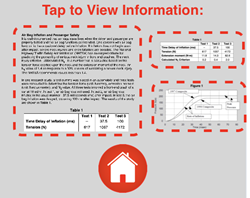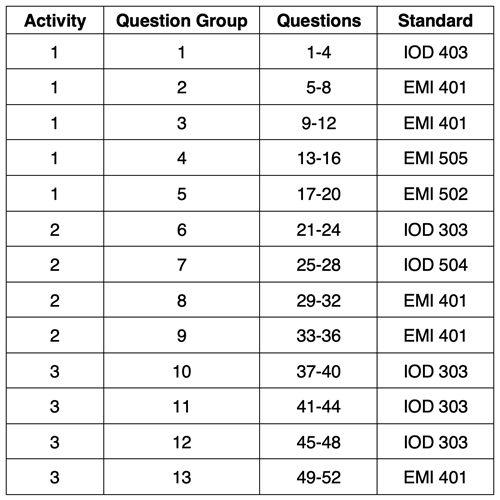About the Science Reasoning Center
 Highly Recommended
Highly RecommendedLike all our Science Reasoning Center activities, the completion of the Air Bag Safety activity requires that a student use provided information about a phenomenon, experiment, or data presentation to answer questions. This information is accessible by tapping on the small thumbnails found on the bottom right of every question. However, it may be considerably easier to have a printed copy of this information or to display the information in a separate browser window. You can access this information from this page.
The Standards
The Air Bag Safety activity describes the factors that affect the safe functioning of air bags. Data regarding delay time before inflation, inflation rates and inflation pressures are presented in the form of a table and a graph. Questions target a student's ability to find basic information in a body of text, to recognize patterns within a table of data, to draw conclusions that are consistent with data, to translate information from a table to a graph, to interpret the slope of a graph, and to recognize the implications of experimental findings.
Success with the activity requires some degree of understanding or proficiency with respect to ...
- Developing and Using Models (Science and Engineering Practice 2.3)
Develop, revise, and/or use a model based on evidence to illustrate and/or predict the relationships between systems or between components of a system. - Developing and Using Models (Science and Engineering Practice 2.6)
Develop and/or use a model (including mathematical and computational) to generate data to support explanations, predict phenomena, analyze systems, and/or solve problems. - Analyzing and Interpreting Data (Science and Engineering Practice 4.6)
Analyze data to identify design features or characteristics of the components of a proposed process or system to optimize it relative to criteria for success. - Constructing Explanations and Designing Solutions (Science and Engineering Practice 6.3)
Apply scientific ideas, principles, and/or evidence to provide an explanation of phenomena and solve design problems, taking into account possible unanticipated effects. - Engaging in Argument from Evidence (Science and Engineering Practice 7.6)
Evaluate competing design solutions to a real-world problem based on scientific ideas and principles, empirical evidence, and/or logical arguments regarding relevant factors (e.g. economic, societal, environmental, ethical considerations). - Patterns (Crosscutting Concept 1.4)
Patterns of performance of designed systems can be analyzed and interpreted to reengineer and improve the system. - Cause and Effect (Crosscutting Concept 2.2)
Systems can be designed to cause a desired effect. - Stability and Change (Crosscutting Concept 7.2)
Systems can be designed for greater or lesser stability.
While the Air Bag Safety activity addresses the five NextGen Science and Engineering Practices and the three Crosscutting Concepts above, the activity drew its greatest inspiration from ACT's College Readiness Standards for Science Reasoning. The activity consists of 52 questions organized into 13 Question Groups and spread across the three activities. Two of the three strands (Interpretation of Data - IOD and Evaluation of Models, Inferences, and Experimental Results - EMI) of the College Readiness Standards are addressed in this activity. The code given for the standard includes three letters to indicate the strand and three numbers to indicate the specific standard within that strand. Higher numbers are indicative of more complex science reasoning skills. The relationship between the questions and the standards is as follows:

Complementary and Similar Resources
The following resources at The Physics Classroom website complement the Air Bag Safety Science Reasoning Activity. Teachers may find them useful for supporting students and/or as components of lesson plans and unit plans.
Physics Classroom Tutorial, Momentum and Its Conservation Chapter: Momentum and Impulse Connections
Physics Classroom Tutorial, Momentum and Its Conservation Chapter: Real World Applications
Physics Video Tutorial, Momentum, Collisions, and Explosions: Impulse and Momentum Change
Physics Video Tutorial, Momentum, Collisions, and Explosions: Controlling Collisions
Physics Interactives, Momentum and Collisions: Egg Drop Simulation
Concept Builders, Momentum and Collisions: Law Enforcement - Being Impulsive About Collisions
Concept Builders, Momentum and Collisions: Law Enforcement - Impulse and Force
Concept Builders, Momentum and Collisions: Impulse-Momentum Change Table
Minds On Physics, Momentum and Collisions Module, Missions MC2-MC3
The Calculator Pad, Momentum and Collisions Chapter, Problem Sets MC2 - MC5
Recommended: Print Passage, Tables, and Graphs
Also see: